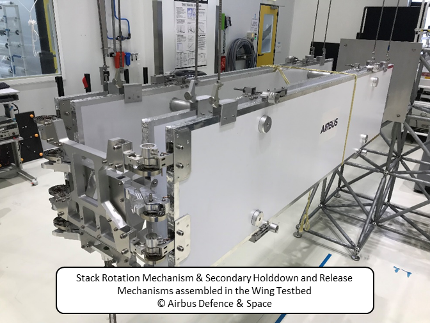-
StatusCompleted
-
Status date2022-01-10
-
Activity Code4F.132
The Flexible Compact Array (FCA) consists of thin flexible blankets equipped with a photovoltaic assembly folded in a zig-zag configuration, which will be deployed using an extendible mast.
Two critical elements of the FCA are developed under this contract, the Stack Rotation Mechanism (SRM) and the Secondary Hold-Down & Release Mechanism (2nd HDRM).
For this project the objectives are:
-
Derivation of unit level requirements for the mechanisms under development
-
Development and test of engineering models of the SRM and 2nd HDRM
-
Realisation of a wing demonstrator that functions as a testbed for the mechanisms under development.

The blanket stack to be released contains a photovoltaic assembly that is sensitive to damage caused by mechanical loads induced by the launch environment and the deployment kinematics. Since the deployment of the solar array is mission critical, a highly reliable set of mechanisms is developed to provide protection during launch and at the same time a low shock release.
The ‘Stack rotation mechanism’ is considered as the most complex and most critical mechanism. This mechanism must rotate the stowed blanket stack 90° with respect to the mast. It shall provide sufficient torque to overcome the harness friction with a factor of 3, in accordance to ECSS. The mechanism is split in two parts, which puts a challenge on hinge alignment.
The Flexible Compact Array (“FCA”) is new type of solar array that is currently being developed. The performance of this solar array is unprecedented. It significantly surpasses conventional, rigid solar arrays in terms of specific stowed volume, specific mass and scalability over a wide range in the high power spectrum (10 kW - 35 kW).
The mechanisms developed are key enablers for the flexible compact array product family approach. Their design will be such that a wide range of FCA wing configurations can be covered with minimal impact on the design and no impact on the qualification status.
The SRM and 2nd HDRM are deployment mechanisms which are applied in the Flexible Compact solar Array (FCA). Both are critical mechanisms used in the deployment sequence of the FCA. The SRM is a set of aligned hinges to deploy the flexible blanket stack from the stowed position (parallel to the mast) to the deployed position (perpendicular to the mast). Once the blanket stack is rotated perpendicularly, the mast is able to deploy, thereby opening the flexible blanket.
The secondary HDRM design is derived from a similar mechanism which has flown on the L-Sat/Olympus flexible solar array which was launched in 1989. Its function is to compress the blanket stack during launch (avoid rattling, gapping, sliding etc.) and during the first stages of deployment. The blanket stack is folded between two pressure plates to which the 2nd HDRM is attached. The 2nd HDRM consists of a number of tensioning units distributed along the long edges of the pressure plates. These tensioning units are released sequentially during operation of the SRM, the final ones being released just before completion of this deployment. When all tensioning units are released, the blanket stack is ready to be deployed.
The wing demonstrator allows for functional and integration testing of the mechanisms developed under this Artes contract.
Each Flexible Compact Array wing can be divided into units, or building blocks, described under that are combined to meet the customer’s requirements on interface, power, volume, etc. The units developed in this project are highlighted:
-
Photovoltaic assembly (PVA)
-
Blanket module
-
Harness
-
Tensioning mechanism
-
Pressure plates
-
Secondary hold-down & release mechanism (2nd HDRM)
-
Stack rotation mechanism (SRM)
-
Telescopic mast
-
Hold-down stack
-
Root hinge
In summary the project covers the following steps:
-
Definition of requirements
-
Complete the conceptual design
-
Preliminary design of the individual items:
-
Stack Rotation Mechanism
-
Secondary Holddown and Release Mechanism
-
-
Design of a wing mock-up
-
Assembly of the breadboard versions of the mechanisms
-
Assembly of wing mock-up, integration of the breadboard mechanisms
-
Functional testing of the breadboard mechanisms
-
Design & manufacturing of the EM mechanisms
-
Testing of the EM mechanisms
-
Analysis of results
-
Test reporting
The milestones defined for the project are: Kick-Off, Preliminary Design Review (PDR), Critical Design Review (CDR) and Final Review (FR).
The Artes C&G project for the development of the Stack Rotation and Release Mechanisms has been completed successfully. The major achievement of this project was the integration and testing of the different (sub)-mechanisms, i.e.
-
The secondary holddown and release system
-
The stack rotation mechanism
Valuable experience has been gained during the assembly, integration and tests of these mechanisms and several design changes and other improvements are foreseen in the upcoming design update of these mechanisms. All key objectives of the mechanism development have been reached.


